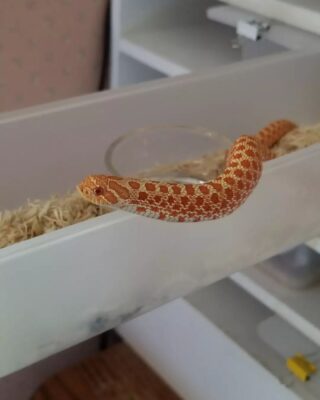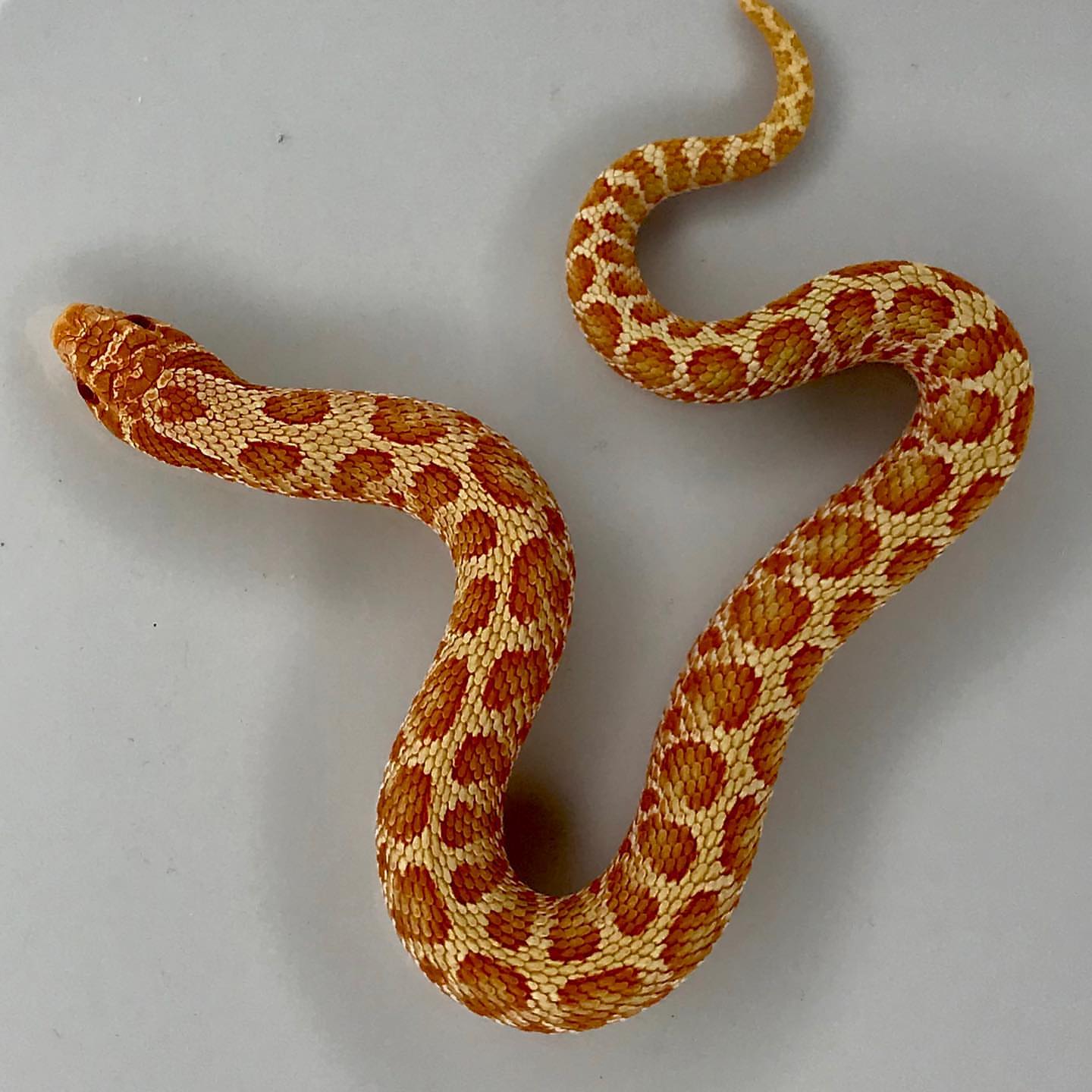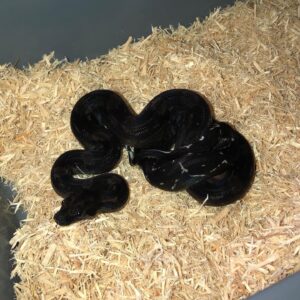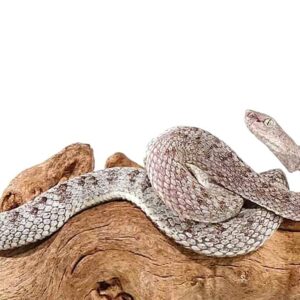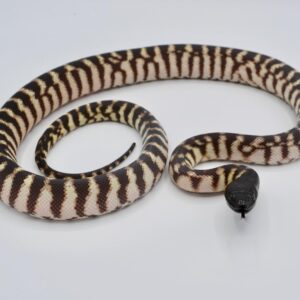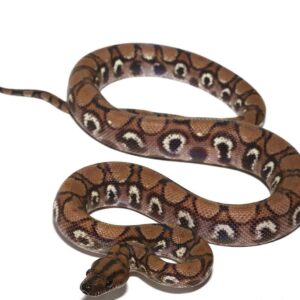Albino Hognose For Sale
$300.00
Albino Hognose snake is found throughout Southern Canada through the United States up to northern Mexico. It is a frequent visitor to areas with clay or sandy soils. These include grasslands, swamps, and floodplains semi-deserts, and even some semi-agricultural areas.
Albino Hognose are comparatively tiny large, robust-bodied snakes. Their color and pattern are extremely diverse. Males are less tame than females, and adult lengths that are rarely greater than 38-51cm (15-20 inches). They get their name due to the form of their nose, which is created by an upturned matter, giving a “hog-like” appearance.
The Albino Hognose Snake isn’t venomous, however it has saliva that can result in symptoms such as mild itching and swelling.
Hides
A large enclosure allows you to have additional hiding places that will enable the hognose to keep cover when feeling stressed. You can include a hide on the hot side and the cold front so that the snake can have different options.
Additionally, a large hide is easy to clean and sanitize. However, the hiding place should only accommodate a coiled hognose and not too big that it will not be usable.
You can also include extra items in the enclosure like logs and branches to make a cozy spot for the hognose as you will often see your snake climbing on them. If you decide to keep the snake in a biologically active cage, you can include a nutrient fertile soil and clay mix. We recommend keeping the cage furniture simple.
Also, keep a sturdy, clean water bowl in the snake’s enclosure. It should be dense so that it doesn’t tip over and spill the water. The container should be disinfected regularly and changed every few days.
Description
Albino hognose snake foor sale Behavior and Temperament
Albino hognose snake foor sale are renowned for their generally docile nature, making them a popular choice among reptile enthusiasts. These snakes exhibit a calm demeanor, which contributes to their suitability as pets. When handled regularly from a young age, albino hognose snakes tend to be quite tolerant of human interaction, rarely displaying aggression. This characteristic makes them an excellent choice for both novice and experienced snake owners.
A notable aspect of albino hognose snake behavior is their unique defensive tactics. Unlike many other snakes that may strike when threatened, hognose snakes have developed intriguing methods to deter predators. One of their most remarkable behaviors is playing dead, a tactic known as thanatosis. During this display, the snake will roll onto its back, open its mouth, and even emit a foul-smelling substance from its cloaca to mimic the scent of decay. This convincing act often dissuades potential threats, allowing the snake to escape unharmed.
Another distinctive defensive behavior is the flattening of their necks to resemble a cobra’s hood. This bluff display is intended to make the snake appear larger and more intimidating. While this behavior may seem alarming to the uninitiated, it is a harmless and fascinating trait. In captivity, albino hognose snakes rarely resort to these defensive tactics, as they typically feel secure in their environment.
Overall, the temperament of albino hognose snakes is gentle and captivating. Their interactions with humans are generally positive, and their unique behaviors add to their charm. These snakes are well-suited to life as pets, provided they are given proper care and attention. Understanding their behaviors helps owners appreciate the complexity and beauty of these remarkable reptiles.
Habitat and Natural Environment
Hognose snakes, including their albino variants, are native to a variety of environments in North America. Typically, these snakes thrive in sandy or loose soil areas, which facilitate their burrowing behavior. They are commonly found in prairies, fields, and open woodlands where the ground is soft enough to dig. The habitat preference of hognose snakes includes regions with moderate vegetation, which provides both coverage from predators and a suitable hunting ground for their primary diet of amphibians, small rodents, and birds.
The albino hognose snake, characterized by its lack of pigmentation, faces unique challenges in the wild. While their vibrant coloration can be visually striking, it also makes them more visible to predators. This increased visibility can affect their survival rates in natural habitats where camouflage is crucial for avoiding predators. Consequently, albino hognose snakes are less commonly found in the wild compared to their normally pigmented counterparts.
When considering the care of hognose snakes in captivity, it is essential to replicate their natural environment to ensure their well-being. This includes providing a substrate that allows for burrowing, such as aspen shavings or a mix of sand and soil. Additionally, they require a temperature gradient within their enclosure to regulate their body temperature effectively. A basking spot with a temperature of around 85°F (29°C) and a cooler area around 70°F (21°C) is ideal. Humidity levels should be kept moderate, as excessively damp conditions can lead to respiratory issues.
For albino hognose snakes, it is also important to consider their heightened sensitivity to light due to their lack of pigmentation. Providing shaded areas within their enclosure can help them avoid excessive exposure to bright lighting. By mimicking their natural habitat and addressing their specific needs, albino hognose snakes can thrive in captivity just as they would in the wild.
Diet and Feeding Habits
Albino hognose snakes, like their naturally colored counterparts, exhibit a varied diet both in the wild and in captivity. In the wild, their diet primarily consists of amphibians, such as toads and frogs, which they are particularly adept at hunting due to their specialized resistance to amphibian toxins. Additionally, they occasionally consume small mammals, birds, and reptile eggs, showcasing their opportunistic feeding nature.
In a captive environment, albino hognose snakes can thrive on a diet primarily composed of appropriately sized rodents. Pinkie mice or fuzzy mice are often suitable for younger or smaller snakes, while larger adult snakes can handle adult mice or even small rats. It is crucial to ensure the prey size is appropriate for the snake’s size to prevent regurgitation or other feeding issues. The general rule is that the prey should be no larger than the widest part of the snake’s body.
Feeding frequency for albino hognose snakes varies with age and size. Juveniles typically require feeding every 4 to 5 days to support their rapid growth, while adults can be fed every 7 to 10 days. Overfeeding can lead to obesity and related health issues, so maintaining a regular feeding schedule and monitoring the snake’s body condition is essential.
When feeding albino hognose snakes in captivity, it is advisable to use pre-killed or thawed frozen prey to minimize the risk of injury to the snake. Presenting the prey using tongs can simulate the natural hunting behavior and reduce the risk of accidental bites. Additionally, it is beneficial to feed the snake in a separate container to prevent substrate ingestion and to reduce the likelihood of associating the primary enclosure with feeding, which can lead to increased aggression during handling.
By understanding and replicating the natural diet and feeding habits of albino hognose snakes, keepers can ensure these fascinating reptiles remain healthy and well-nourished in captivity.
Care and Maintenance in Captivity
Proper care and maintenance are essential for ensuring the well-being of albino hognose snakes in captivity. These captivating reptiles require a habitat that closely mimics their natural environment to thrive. The first step in creating a suitable home for your albino hognose snake is selecting an appropriate enclosure. A glass or plastic terrarium with a secure lid is ideal. The size of the enclosure should be at least 20 gallons for an adult snake, providing ample space for movement and enrichment.
Temperature and humidity play crucial roles in the health of albino hognose snakes. These snakes are ectothermic, meaning they rely on external heat sources to regulate their body temperature. Maintain a temperature gradient within the enclosure, with a basking spot at 85-90°F and a cooler area at 75-80°F. Use under-tank heating pads and overhead heat lamps to achieve this gradient. It is equally important to monitor humidity levels, which should be kept between 30-50%. A hygrometer can help ensure these conditions are consistently met.
Choosing the right substrate is another vital aspect of caring for albino hognose snakes. Opt for substrates that allow for burrowing, such as aspen shavings or coconut husk fiber. These materials not only facilitate natural behaviors but also help in maintaining appropriate humidity levels. Avoid substrates like sand or cedar chips, which can cause respiratory issues or other health problems.
General maintenance of the enclosure involves regular cleaning and monitoring. Spot-clean the substrate to remove waste, and perform a thorough cleaning of the enclosure at least once a month. Fresh water should be provided daily in a shallow dish to prevent dehydration. Additionally, albino hognose snakes should be fed appropriately sized prey items, typically once a week, to ensure they receive adequate nutrition.
By adhering to these guidelines, you can create a comfortable and stimulating environment for your albino hognose snake. Proper care and maintenance not only contribute to the snake’s physical health but also enhance its overall quality of life in captivity.
Health and Common Issues
Albino hognose snakes, like any other reptile, can be prone to certain health issues that require careful attention and prompt intervention. One of the primary concerns among albino hognose snakes is genetic conditions, which may manifest due to their unique coloration and breeding history. It is essential for owners to be vigilant about the genetic health of their snake, ensuring that they come from reputable breeders who prioritize healthy breeding practices.
Skin problems are another common concern for albino hognose snakes. Due to their sensitive skin, these snakes may experience shedding difficulties or skin infections if their habitat is not properly maintained. Regular monitoring of the snake’s skin condition, ensuring adequate humidity levels, and providing a clean environment are crucial steps in preventing skin-related issues.
Respiratory infections are also prevalent among albino hognose snakes and can be particularly troubling. Symptoms such as wheezing, mucus around the nostrils, and lethargy can indicate respiratory distress. To mitigate the risk of respiratory infections, it is vital to maintain appropriate temperature and humidity levels within the enclosure and to promptly address any signs of illness.
Identifying health issues early and seeking professional veterinary care are key to ensuring the well-being of albino hognose snakes. Owners should familiarize themselves with the normal behavior and appearance of their snake to spot anomalies quickly. When searching for a qualified reptile veterinarian, it is advisable to look for professionals with specific experience in treating snakes and other reptiles. A reliable veterinarian can provide invaluable guidance on preventative care and treatment options, helping to keep albino hognose snakes healthy and thriving.
By being proactive in their care, understanding common health issues, and establishing a relationship with a skilled reptile veterinarian, owners can significantly enhance the quality of life for their albino hognose snakes.
Breeding Albino Hognose Snakes
Breeding albino hognose snakes requires a comprehensive understanding of both genetic principles and the specific needs of this unique morph. These snakes exhibit an autosomal recessive trait, meaning that both parents must carry the albino gene for their offspring to potentially express the albino phenotype. Therefore, careful selection of breeding pairs is crucial. Breeders often pair a visual albino with a heterozygous (het) albino to increase the likelihood of producing albino offspring.
The breeding cycle of albino hognose snakes generally begins in the early spring, following a winter brumation period. During brumation, the snakes are kept at cooler temperatures for several months to mimic their natural environment, which is essential for stimulating reproductive behavior. Post-brumation, the snakes are gradually warmed up and introduced to each other. It is important to monitor the snakes closely during this period, as males can sometimes become overly aggressive.
Successful copulation will lead to the female laying eggs, typically within 30 to 45 days. Eggs should be carefully incubated at a stable temperature of around 82-85°F (28-29°C) with proper humidity levels to ensure healthy development. Incubation generally lasts between 50 to 60 days. Breeding albino hognose snakes can be challenging, as it requires meticulous attention to detail and an investment in proper equipment.
Caring for hatchlings involves setting them up in small, secure enclosures with appropriate heating and humidity. Hatchlings should be offered small, appropriately sized prey items, and it may take a few attempts before they begin feeding regularly. Breeders must be vigilant in monitoring the health and growth of the hatchlings, ensuring they are free from any genetic anomalies or health issues.
The rewards of breeding albino hognose snakes are manifold. Not only does it contribute to the conservation and understanding of this captivating morph, but it also provides enthusiasts with the opportunity to witness the development of these unique creatures from eggs to fully-grown adults. However, responsible breeding practices are paramount. This includes ensuring genetic diversity, avoiding inbreeding, and providing optimal care for both breeding adults and their offspring. By adhering to these guidelines, breeders can help maintain healthy, thriving populations of albino hognose snakes.
